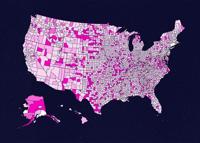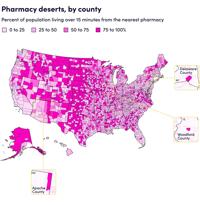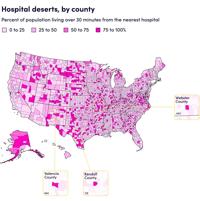Why medical deserts are on the rise—and how patients there are accessing in-person care
- Sarah Conlisk for Lyft
- Updated
- 0
explains how, with medical deserts growing across the country, patients are seeking transportation workarounds to get to routine medical and pharmacy visits.
Why medical deserts are on the rise—and how patients there are accessing in-person care
Updated

Twenty-one percent of adults without access to a vehicle or public transit in 2022. It's a sobering stat that points at a real problem: Unlike online shopping or dinner delivery, people need to get to health care to actually receive it. This is trickier in regions where essential medical services are hard to reach, often called "medical deserts." In these areas, even routine medical visits can become ordeals.
Take the simple act of picking up a prescription. For many of us, that requires only a quick drive (or even walk): A majority of Americans live within . But the U.S. has seen a 15% decline in retail pharmacies since 2021, leaving many communities without easy, convenient access to medications, explains.
suggests that in 40% of counties, residents have to travel over 15 minutes to get to nearby pharmacies—but it's in the rural states of North Dakota, Alaska, and Montana, and the more urban states of Texas and Georgia—where riders have to travel the farthest. The situation is particularly striking in Apache County, Arizona; Woodford County, Illinois; and Delaware County, New York—which are the three largest counties where 100% of residents live in pharmacy deserts.

Pharmacy Deserts Across the Country
Updated

Long pharmacy rides were generally more common in rural counties, with under 50 people per square mile. Among high-density counties, pharmacy deserts are 30% more likely to occur in counties with a higher share of African American residents.
LyftMedical Care Issues Add to Pharmacy Desert Existence
Updated

Pharmacies are only part of the problem—there are also disparities in access to medical care. The average American lives roughly away from a hospital, and many have to for routine health care visits. This distance is not just an inconvenience: Living far from a medical facility is associated with physician and for patients with cancer and .
GoodRX data suggests that across the U.S., 20% of counties are hospital deserts, where the closest hospital is generally over 30 minutes away. These rates are twice as high in Alaska, North Dakota, and Missouri, and there are several counties where all residents have to travel over 30 miles to get to a hospital–those with populations over 38,000 include Valencia County, New Mexico; Webster County, Missouri; and Kendall County, Texas.
LyftOne in Four Patients Use Rideshare to Navigate Health Care Deserts
Updated

While health deserts have long been a problem in the U.S., rideshare is helping to cross them. Visits to and from health care facilities have emerged as a major use case for rideshare services, with 26% of riders in a reporting using rideshares to access health care services.
To meet the demand for convenient and reliable transportation in these medical care deserts, thousands of hospitals partner directly with rideshare companies, some of which are authorized as non-emergency medical transportation services, to provide transportation to appointments and pharmacies.
was produced by and reviewed and distributed by Stacker.
LyftOriginally published on , part of the .
Tags
Weather Alert
...Gusty Thunderstorms with Small Hail and Cold Air Funnel Clouds through Early Tonight... Gusty thunderstorms capable of producing cold air funnel clouds and small hail are forecast through early tonight. These cold air funnels are developing underneath thunderstorms that are moving across the area. Underneath these showers...spinning columns of air that look like tornadoes may continue to develop. These funnels usually are very brief and rarely touch the ground. If these funnels do touch down...they most likely will not cause damage to life or property. Cold air funnels are due to very cool air aloft...warm moist air near the ground...and are usually in association with a strong area of low pressure in the upper levels of the atmosphere. Due to little or no wind shear...they are usually weak and very brief.
Currently in Carterville
